
Know that all beautiful, glorious and mighty creations spring from but a spark of My splendor.
[Bhagavad-gita 10:41]
Many indigenous and first nations peoples who were once termed “primitive,” observing the natural phenomena surrounding them, rightly concluded that for anything to be created there must be a creator. They see the harmony in nature, the sun rising and setting, the changing seasons, the movement of the tides with the phases of the moon, and they instinctively know that there is a Great Spirit – a Supreme Being – behind it all. For instance the Lakota Sioux nation revere and seek guidance from the supernatural Being they call “Wakan Tanka.”

So in this sense, these people of simple faith are actually greater scientists, greater “knowers of the truth,” than those who sit in laboratories all day behind their telescopes and microscopes and Large Hadron Colliders, observing the overwhelming proof of intelligent design within the universe, and out of envy of the Supreme Intelligent Being, wrongly concluding that it is the product of billions of mindless accidents. We are not at all suggesting that all scientists are like that. Even a very simple person can understand that there cannot be creation without a creator, there cannot be laws of nature without a lawmaker, and there cannot be energy without an energetic source.
There is a famous Anglican hymn, called All Things Bright and Beautiful which was written in the late 1840’s. It was inspired by the natural beauty of the Usk River valley in Monmouthshire, Wales.
All Things Bright and Beautiful

All things bright and beautiful
All creatures great and small
All things wise and wonderful
The Lord God made them all

Each little flower that opens
Each little bird that sings
He made their glowing colours
He made their tiny wings

The purple headed mountain
The river running by
The sunset and the morning
That brightens up the sky

The cold wind in the winter
The pleasant summer sun
The ripe fruits in the garden
He made them every one

The tall trees in the greenwood
The meadows where we play
The rushes by the water
We gather every day

He gave us eyes to see them
And lips that we might tell
How great is God Almighty
Who has made all things well

However, about ten years after the writing of this hymn, with its simple and child-like faith in the existence of a Divine Creator, Charles Darwin was to publish his first book, “The Origin of Species,” in 1859. Darwin’s book was to have a profound influence on the views of modern mankind, creating doubt in many people’s hearts and minds as to the existence of the “Heavenly Father Who created heaven and earth.” One hundred and sixty odd years later, Darwin’s Theory of Evolution is in trouble, as many advances in scientific knowledge, especially in the fields of molecular science and astrophysics, are proving the theory to be untenable – incapable of being maintained or defended.
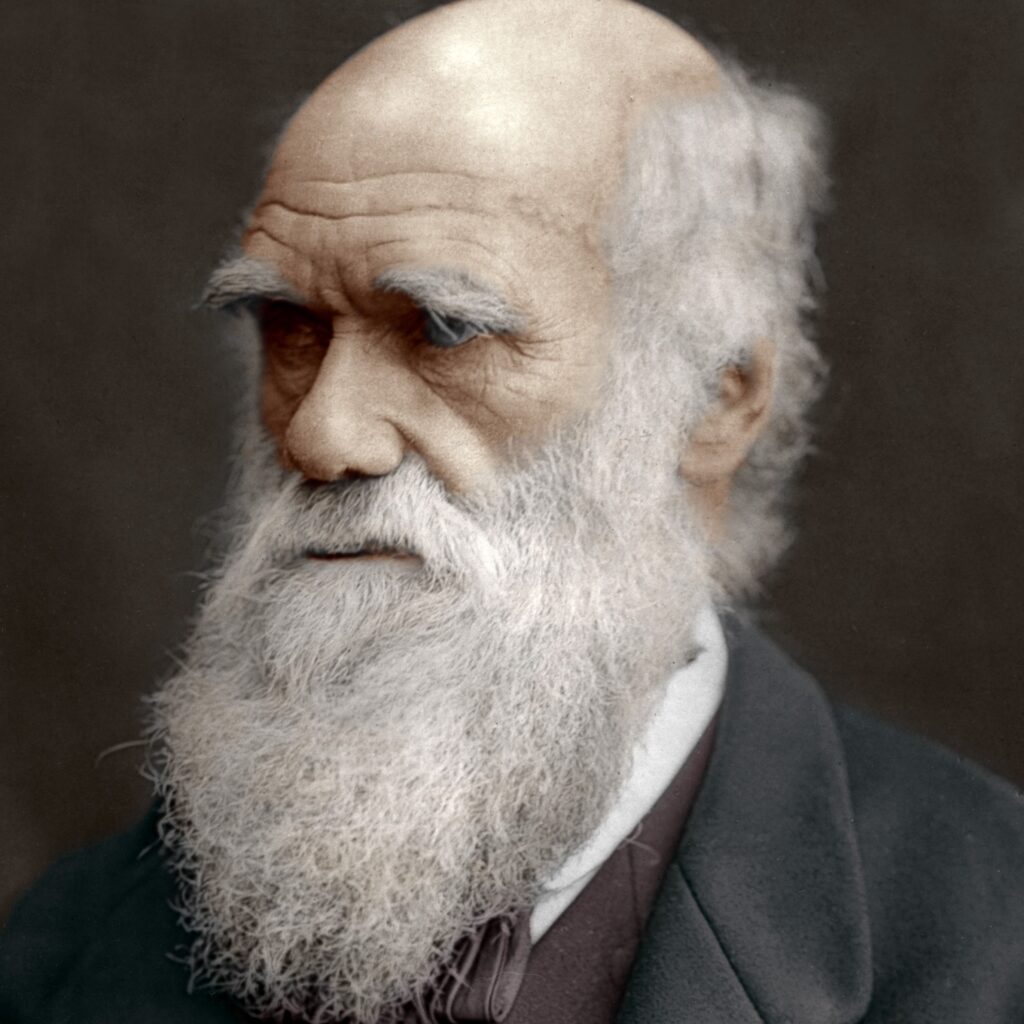
Blinded by Science
Science is so inaccessible to the average person, so mysterious, so incomprehensible, that most people are in awe of the scientists. And the scientists largely see those who are untrained in scientific thought as superstitious and naïve sentimentalists or intellectual Neanderthals who don’t have the ammunition to figure out anything of real importance. The common man is too intimidated to question their findings, and so this small group of big-brained individuals has been dictating reality to the rest of society for well over a century. And though they have made many amazing discoveries and inventions, when it comes to the beginnings of life and the creation of the cosmos, they have bluffed the common people into thinking that they have a monopoly on the truth, and that Darwin’s Theory is a law which cannot be refuted. They have blinded us with science.

Thus, all the text books, all the museums, all the universities and high school science teachers, and all those institutions who give research grants and pay the wages of many scientists, are pushing the barrow of Charles Darwin, despite the fact that Darwin’s Theory remains unproven. This has meant that many scientists have been coerced into hiding their doubts about Darwin in order to get work, get grants or get published. However, in the last thirty or forty years, many scientists have broken rank with the scientific community as modern scientific discoveries increasingly cast doubt over the Darwinist conclusions.
An increasing number of evolutionary scientists have concluded there is some sort of supernatural plan or agency behind the laws and constants of physics, because of how minutely precise they must be for the universe or life to exist at all. A Wall Street Journal [December 1997] article entitled Science Resurrects God, reported:
Scientists … often change their minds when they see new evidence. I was reminded of this a few months ago when I saw a survey in the journal ‘Nature.’ It revealed that 40% of American physicists, biologists and mathematicians believe in God – and not just some metaphysical abstraction, but a deity who takes an active interest in our affairs and hears our prayers …
A survey of scientists who are members of the American Association for the Advancement of Science, conducted by the Pew Research Center for the People & the Press in May and June 2009, found that just over half of scientists (51%) believe in some form of deity or higher power. 33% of scientists say they believe in God, while 18% believe in a universal spirit or higher power. The poll of scientists found that four-in-ten scientists (41%) say they do not believe in God or a higher power.
Seeing is Believing
In the book Life Comes from Life, Srila Bhaktivedanta Swami, himself a university educated chemist in his householder life, states:
The scientific method includes observation, hypothesis and then demonstration. Then it is perfect.
So, the scientific method begins with observation. There is a saying: “seeing is believing.” Science observes physical evidence, and attempts to reason from that observed evidence to form ideas, tests and conclusions about how things work. If processes operate consistently, scientists attempt to represent their behaviour in mathematical formulas for more precise understanding. So, what does the physical evidence suggest? Are evolutionary scientists simply observing the physical evidence in relation to life and the formation of the universe, or are they endeavouring to prove something that goes against the overwhelming physical evidence which points towards an intelligent designer of the universe.
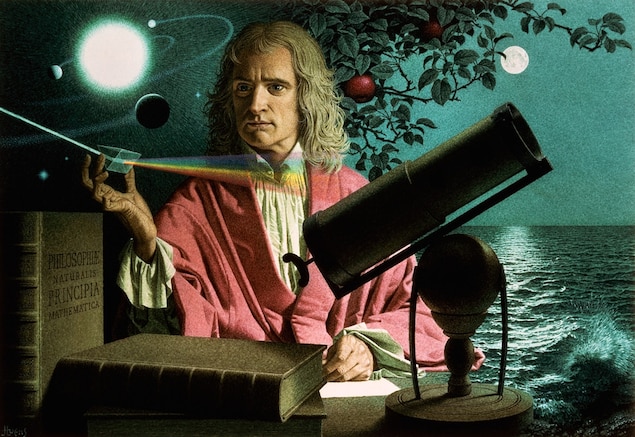
Sir Isaac Newton
Sir Isaac Newton (1642-1727) was an English physicist, mathematician, astronomer and theologian. He was a brilliant scientist for his time, and he built the first practical reflecting telescope. He was also an ordained Christian minister. Newton often told the story that he was inspired to formulate his theory of gravitation by watching an apple fall from a tree. We can go into any apple orchard and observe apples falling from trees. But where do we go to observe humans evolving from apelike ancestors? Apples falling from trees fits into the category of science we can term operations science, which utilizes data that are repeatable and observable at any time.
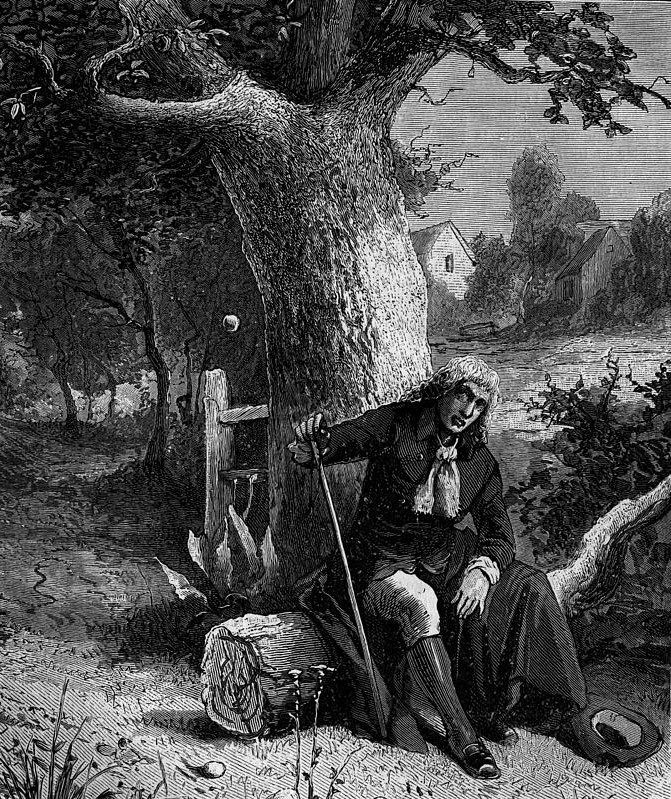
Phillip E. Johnson, the recently deceased author of Darwin On Trial and one of the leaders of the Intelligent Design Movement, argues:
Most evolutionists, naturalists and atheists agree with intelligent design and creation advocates that our universe appears to be carefully designed. Considering this agreement, why is there an intelligent design vs. evolution debate at all, if science is first based on observable phenomena? The reason for disagreement is that evolutionary atheists and naturalists don’t want to believe there is a conscious, intelligent designer. They have an a priori adherence, a pre-conceived bias against the concept of there being a Supreme Being who is more intelligent than they are. Out of their enviousness of God, they disbelieve what they clearly observe, choosing instead to believe what they see is a grand illusion, and that incredibly complex design, including life, came about by accidental means rather than being the work of an intelligent, conscious Creator. … Richard Dawkins himself began [his book] “The Blind Watchmaker,” … with the observation:
“Biology is the study of complicated things that give the appearance of having been designed for a purpose.”
Dawkins also agrees that living organisms contain vast quantities of genetic information, far more than in a typical computer program. In Dawkins’ own words: “Physics books may be complicated, but … the objects and phenomena that a physics book describes are simpler than a single cell in the body of its author. And the author consists of trillions of those cells, many of them different from each other, organized with intricate architecture and precision-engineering into a working machine capable of writing a book. … Each nucleus … contains a digitally coded database larger, in information content, than all 30 volumes of the Encyclopedia Britannica put together. And this figure is for each cell, not all the cells of the body put together.”
[The Blind Watchmaker, p. 2-3]
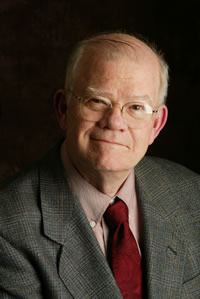
Phillip E Johnson [1940-2019]
Phillip E. Johnson continues, citing the renowned geneticist Francis Crick in order to illustrate the fact that the biological world has the strong appearance of being designed:
One of the world’s most famous scientists, probably the most famous living biologist, is Sir Francis Crick, the British co-discoverer of the structure of DNA, a Nobel Prize winner. … Crick is also a fervent atheistic materialist, who propounds the particle theory. In his autobiography, Crick says very candidly biologists must remind themselves daily that what they study was not created, it evolved; it was not designed, it evolved. Why do they have to remind themselves of that? Because otherwise, the facts which are staring them in the face and trying to get their attention might break through. What we discovered when I [Johnson] developed a working group of scientists, philosophers, et al., in the United States was that living organisms look as if they were designed and they look that way because that is exactly what they are.
[Phillip E. Johnson, Essay: “Evolution and Christian Faith.” Francis Crick, “What Mad Pursuit: A Personal View of Scientific Discovery,” Basic Books 1990, p. 138]
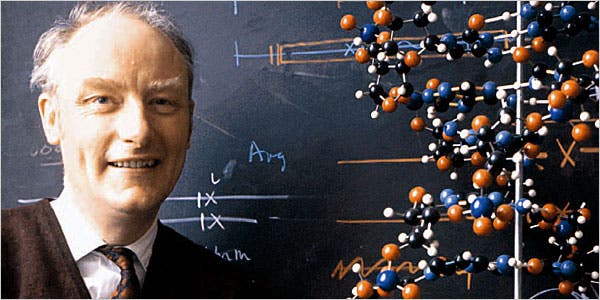
Sir Francis Crick
Eminent Scientists on the Appearance of Intelligent Design
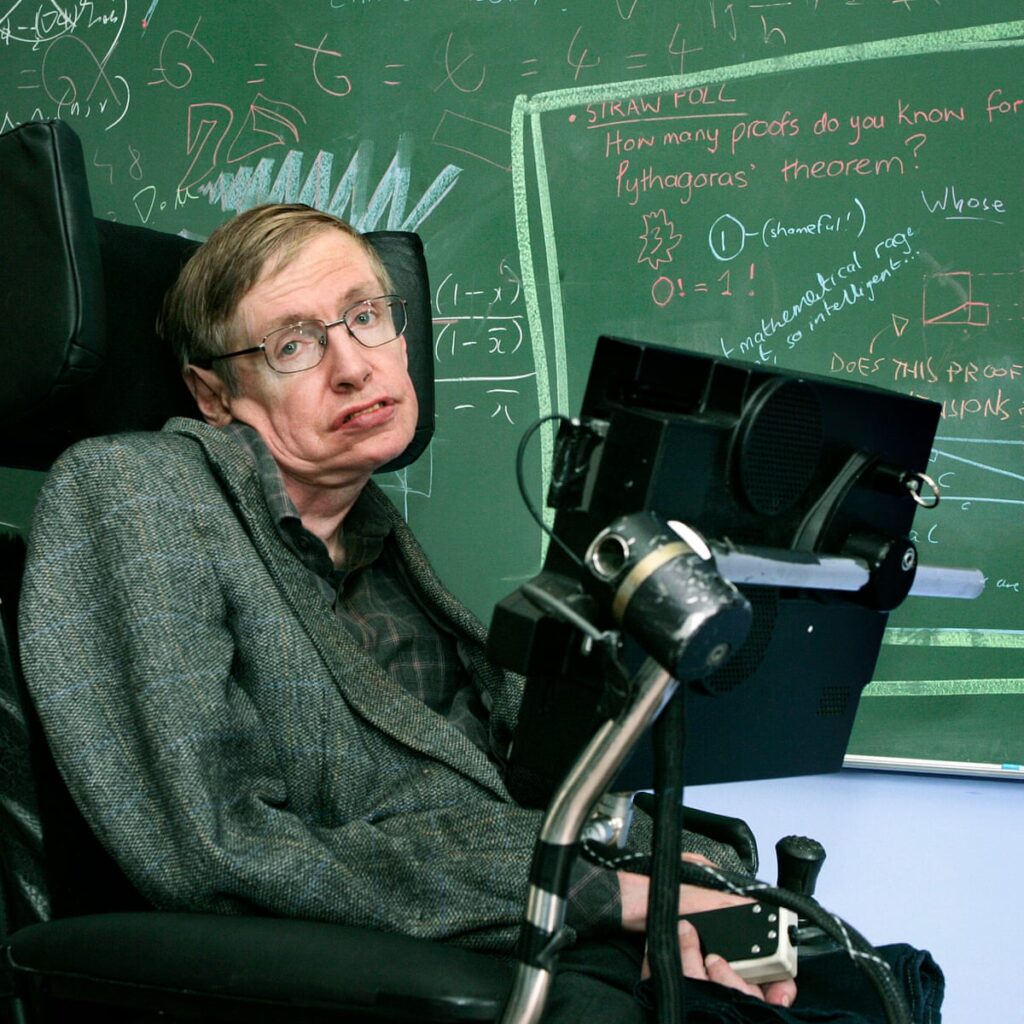
Stephen Hawking
Even Stephen Hawking has conceded:
The odds against a universe like ours emerging out of something like the Big Bang are enormous … I think clearly there are religious implications whenever you start to discuss the origins of the universe.
[Stephen Hawking, “A Brief History of Time: From the Big Bang to Black Holes,” Bantam Books 1998, p. 128]
Sir Fred Hoyle was a distinguished British astronomer and Professor of Astronomy at Cambridge University. He is an evolutionist and agnostic. Hoyle developed the steady state theory of cosmology and was considered for the Nobel Prize. In 1982, Hoyle presented Evolution from Space for the Royal Institution’s Omni Lecture. After considering the very remote probability of evolution he concluded:
If one proceeds directly and straightforwardly in this matter, without being deflected by a fear of incurring the wrath of scientific opinion, one arrives at the conclusion that biomaterials with their amazing measure or order must be the outcome of intelligent design. No other possibility have I been able to think of …
[Hoyle, Fred, “Evolution from Space, Omni Lecture,” Royal Institution, London, January 12, 1982, pp. 27–28]
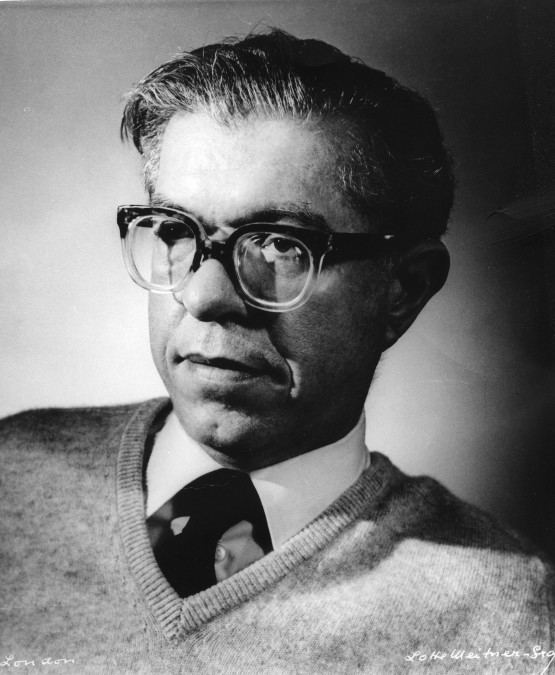
Sir Fred Hoyle
After years of study, Hoyle estimated the chances of the random emergence of even the simplest cell:
The chance that higher life forms might have emerged in this way is comparable with the chance that a tornado sweeping through a junk yard might assemble a Boeing 747 from the materials therein.
[“Hoyle on Evolution” Nature, vol. 294, 12 Nov. 1981, p. 105]
Hoyle also compared the chance of obtaining even a single functioning protein by chance combination of amino acids to a solar system full of blind men solving Rubik’s Cube simultaneously.
A common sense interpretation of the facts suggests that a super intellect has monkeyed with physics, as well as chemistry and biology, and that there are no blind forces worth speaking about in nature. The numbers one calculates from the facts seem to me so overwhelming as to put this conclusion almost beyond question.
[Fred Hoyle, “The Intelligent Universe: A New View of Creation and Evolution,” London: Michael Joseph Limited 1983]
Hoyle further said:
The likelihood (probability) of the spontaneous formation of life from inanimate matter is one to number with 40,000 noughts after it … It is big enough to bury Darwin and the whole theory of evolution. There was no primeval soup, neither on this planet nor on any other, and if the beginnings of life were not random, they must therefore have been the product of purposeful intelligence.
[Sir Fredrick Hoyle and Chandra Wickramasinghe, “Evolution from Space,” Simon & Schuster 1984, p. 148]
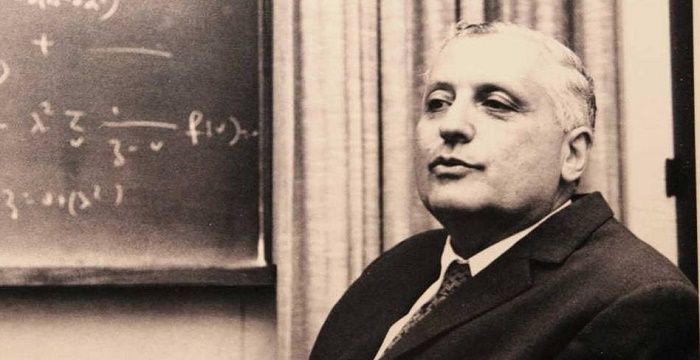
Ilya Prigogine
Ilya Prigogine was an eminent chemist and physicist who received two Nobel Prizes in chemistry. Regarding the probability of life originating by accident, he said:
The statistical probability that organic structures and the most precisely harmonized reactions that typify living organisms would be generated by accident is zero.
[I. Prigogine, N. Gregair, A. Babbyabtz, “Physics Today” 25, pp. 23-28]
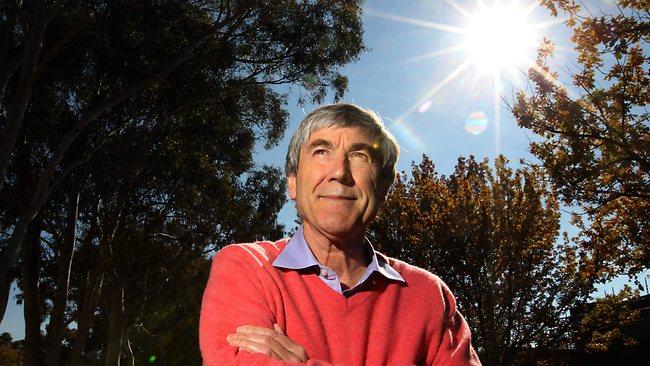
Paul Davies
Paul Davies is a noted physicist, cosmologist, astrobiologist and author, was Professor of Mathematical Physics at The University of Adelaide, and helped found the Australian Centre for Astrobiology in Sydney, Australia. However, Davies stated:
The laws [of physics] … seem to be the product of exceedingly ingenious design … The universe must have a purpose.
[Paul Davies, “Superforce: The Search for a Grand Unified Theory of Nature,” Simon & Schuster 1984, p. 243]
I belong to the group of scientists who do not subscribe to a conventional religion but nevertheless deny that the universe is a purposeless accident. Through my scientific work I have come to believe more and more strongly that the physical universe is put together with an ingenuity so astonishing that I cannot accept it merely as a brute fact. There must, it seems to me, be a deeper level of explanation. Whether one wishes to call that deeper level ‘God’ is a matter of taste and definition.
I hope the foregoing discussion will have convinced the reader that the natural world is not just any old concoction of entities and forces, but a marvellously ingenious and unified mathematical scheme … these rules look as if they are the product of intelligent design. I do not see how that can be denied.
[Paul Davies, “The Mind of God: The Scientific Basis for a Rational World,” Simon & Schuster 1993, p. 16, 214]
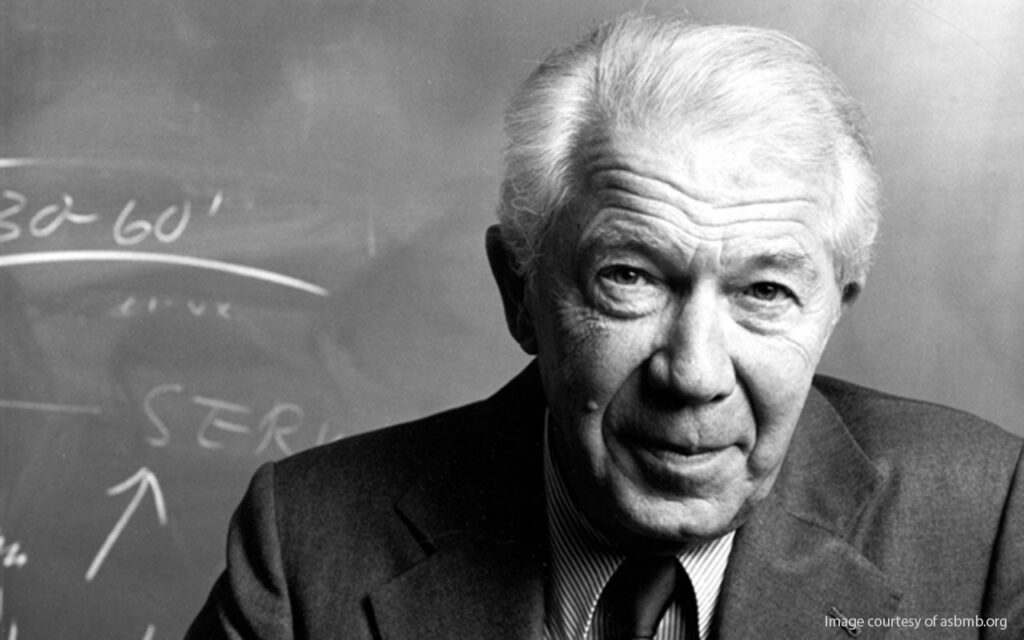
Christian de Duve
Christian de Duve is an internationally acclaimed organic chemist who received a Nobel Prize for Physiology of Medicine for describing the structure and function of organelles in biological cells. Regarding chance assembly of even one single bacteria, he says:
If you equate the probability of the birth of a bacteria cell to chance assembly of its atoms, eternity will not suffice to produce one. Faced with the enormous sum of lucky draws behind the success of the evolutionary game, one may legitimately wonder to what extent this success is actually written into the fabric of the universe.
[Christian de Duve, “A Guided Tour of the Living Cell,” W.H. Freeman & Company; 1984]
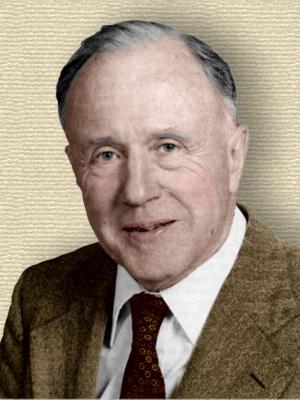
John Wheeler
John Wheeler, the eminent theoretical physicist who helped invent the theory of nuclear fission and coined the term “black hole,” said:
A life-giving factor lies at the centre of the whole machinery and design of the world.
[John Wheeler, from John Barrow and Frank Tipler, “The Anthropic Cosmological Principle,” Clarendon Press 1986, Introduction, p. vii]
A point worth mentioning is that many scientists often refer to the Big Bang as the cause of the universe, the cause of all causes. They often say that nothing existed before the Big Bang. However, to have a Big Bang, or any explosion or fire, we must have fuel and heat and oxygen – we must have pre-existing material elements: earth, fire, air etc. So where did these elements come from? And how does a perfectly ordered universe, with all the conditions necessary for life, come from an explosion? How does order come from destruction and chaos?
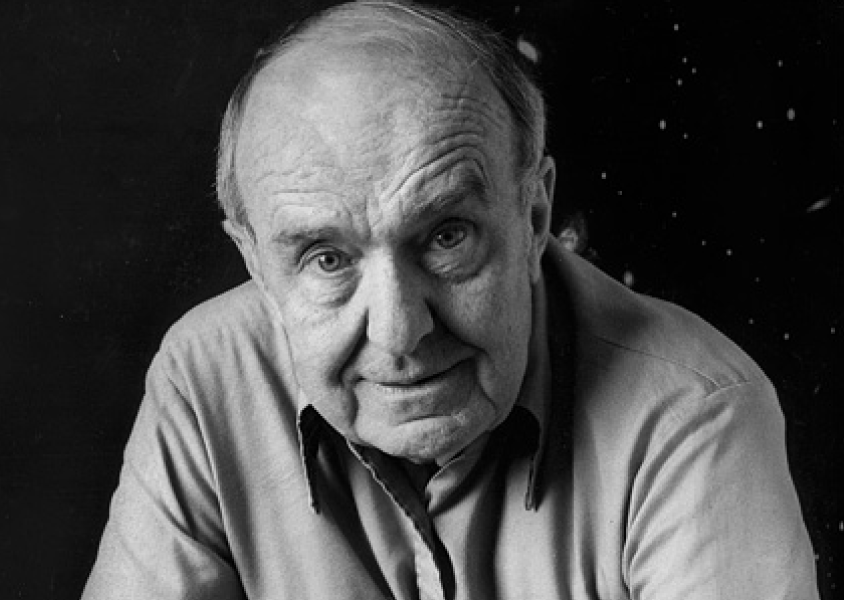
Alan Sandage
Alan Sandage, world renowned cosmologist and winner of the Crawford prize in astronomy, said:
I find it quite improbable that such order came out of chaos. There has to be some organizing principle. God to me is a mystery but is the explanation for the miracle of existence, why there is something instead of nothing.
[Alan Sandage, J.N. Willford “Sizing up the Cosmos: An Astronomers Quest,” New York Times, March 12, 1991]
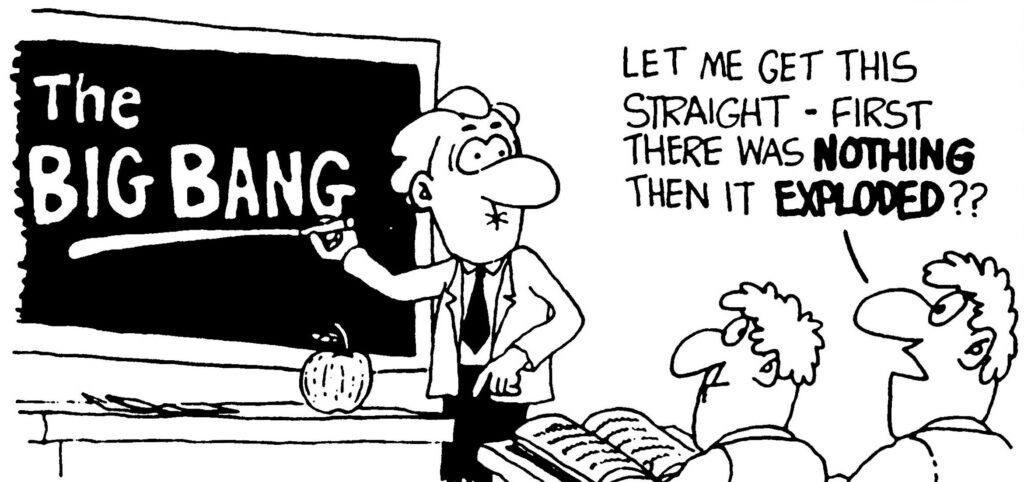
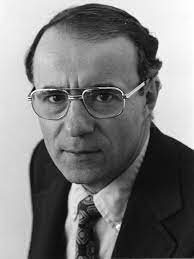
Arno Penzias
The eminent astrophysicist Arno Penzias was co-awarded the Nobel Prize in Physics for discovery of a faint microwave background radiation throughout the universe, which supposedly lent strong support to the big-bang model of cosmic evolution. However, he admitted:
Astronomy leads us to a unique event, a universe which was created out of nothing, one with the very delicate balance needed to provide exactly the conditions required to permit life, and one which has an underlying [one might say ‘supernatural’] plan.
[Arno Penzias, “Cosmos, Bios, and Theos,” Margenau, H and R.A. Varghese, ed., Open Court Publishing, 1992, p. 83]
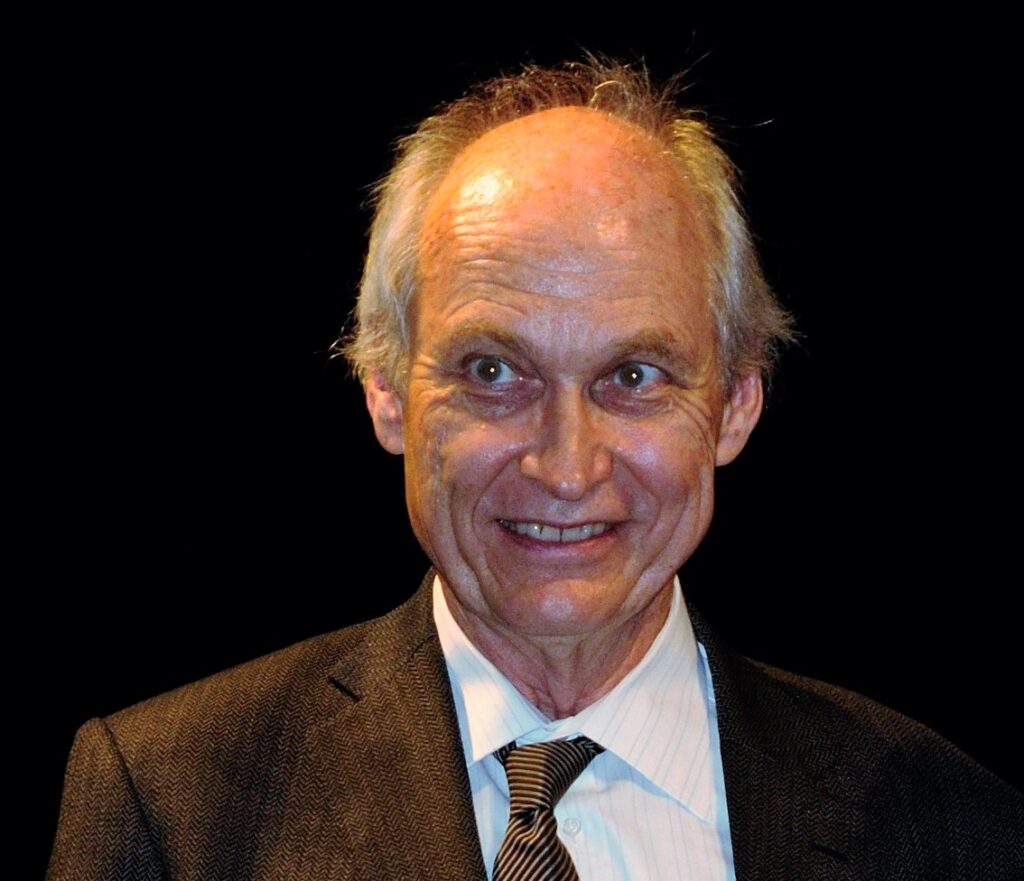
Michael S Turner
Michael S Turner, the widely quoted astrophysicist at the University of Chicago and Fermilab, describes the fine-tuning of the universe as follows:
The precision is as if one could throw a dart across the entire universe and hit a bull’s-eye one millimetre in diameter on the other side.
[Robin Collins, “The Evidence for Fine-Tuning” in “God and Design: The Teleological Argument and Modern Science,” ed. Neil Manson, Routledge, 2003]
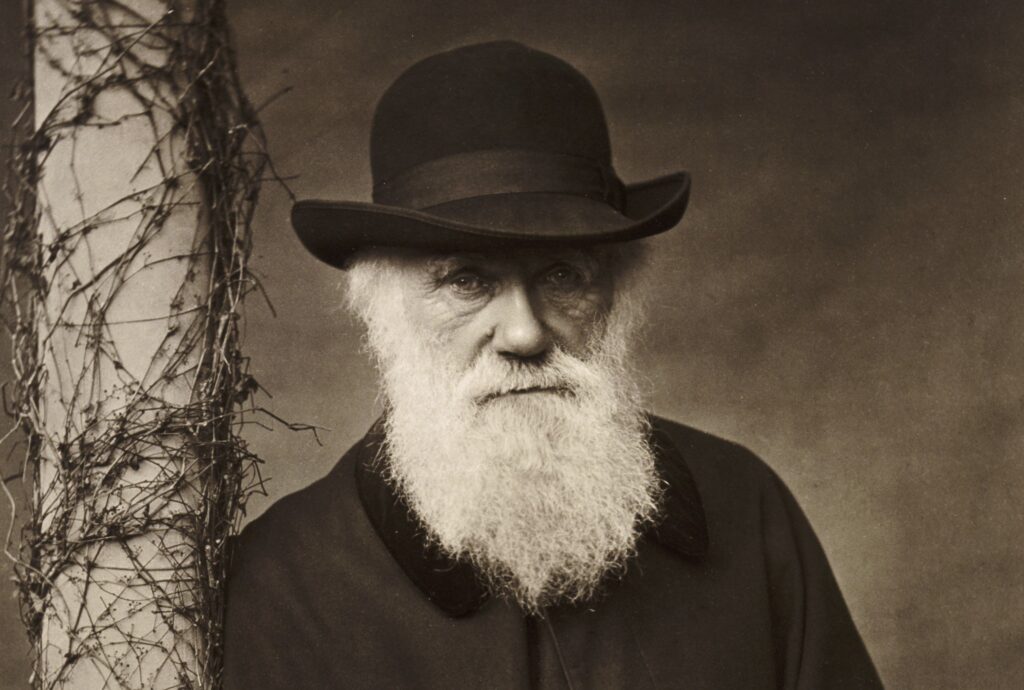
Charles Darwin
Charles Darwin himself said of the human eye:
To suppose that the eye with all its inimitable contrivances for adjusting the focus to different distances, for admitting different amounts of light, and for the correction of spherical and chromatic aberration, could have been formed by natural selection, seems, I freely confess, absurd in the highest degree.

Why Don’t Evolutionists Believe What They See?
Special creation by God is obvious, since experience throughout history reveals advanced complexity always comes from an intelligent designer. Complexity in our most advanced technology and machines exists only because it is designed by living intelligence, so how can people believe otherwise with infinitely more complex and purposeful machinery throughout the entire inorganic universe and in every form of life?

Robert Jastrow
Professor Robert Jastrow was founder of NASA’s Goddard Institute, and is now director of the Mount Wilson Institute and its observatory. He observed:
This is an exceedingly strange development, unexpected by all but the theologians. They have always accepted the word of the Bible: In the beginning God created heaven and earth… [But] for the scientist who has lived by his faith in the power of reason, the story ends like a bad dream. He has scaled the mountains of ignorance; he is about to conquer the highest peak; [and] as he pulls himself over the final rock, he is greeted by a band of theologians who have been sitting there for centuries.
[Robert Jastrow, God and the Astronomers, New York, NY: W.W. Norton and Co., 1978, p. 116]
Seeing is believing, but leading evolutionists have concluded seeing is not believing. They fully acknowledge that the universe and life appear to be designed, but unscientifically and irrationally conclude it was not designed. Instead of reasoning from observed evidence to the logical and scientific conclusion that there is a designer of the universe and life, evolutionists assume against all odds that there is no designer, force-fit all observed evidence into their idea, and ignore the obvious.
It is profound how far people will go to avoid God’s existence. Simply put, there can never be enough evidence to convince someone of something they don’t want to believe. More information doesn’t help if one isn’t open in advance to go wherever the evidence leads. Many claim they don’t have enough information to believe in a Creator, but this is just a cover-up because people don’t want God, and have already rejected Him in their hearts. Evolutionary atheists evade addressing vast and consistent evidence we already have for a living, intelligent Creator, while clinging steadfastly to the hope that conclusive evidence will eventually be found for evolution. This kind of belief without a single working example is blind faith in the “religion” of evolution, not science.
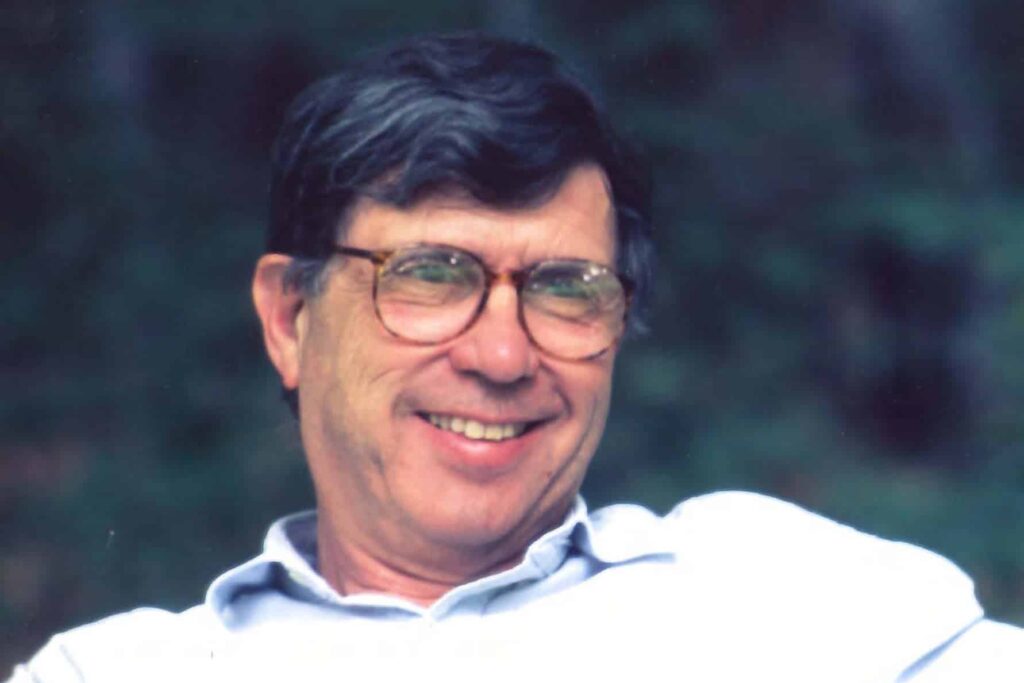
Richard Lewontin
As a world leader in evolutionary biology, atheist, and self-proclaimed Marxist, Richard Lewontin admitted:
We take the side of science in spite of the patent absurdity of some of its constructs, in spite of its failure to fulfil many of its extravagant promises of health and life, in spite of the tolerance of the scientific community for unsubstantiated ‘just-so’ stories, because we have a prior commitment, a commitment to materialism. It is not that the methods and institutions of science somehow compel us to accept a material explanation of the phenomenal world, but, on the contrary, that we are forced by our a priori adherence [prejudice] to material causes to create an apparatus of investigation and a set of concepts that produce material explanations, no matter how counter-intuitive, no matter how mystifying to the uninitiated. Moreover, that materialism is an absolute, for we cannot allow a Divine Foot in the door.
[Richard Lewontin, “Billions and Billions of Demons,” The New York Review, p. 31, January 9, 1997]

Quotes from Albert Einstein
The deep emotional conviction of the presence of a superior reasoning power, which is revealed in the incomprehensible universe, forms my idea of God.
In the view of such harmony in the cosmos, which I with my limited human mind am able to recognize, there are yet people who say there is no God. But what makes me really angry is that they quote me for support for such views.
When I read the Bhagavad-gita and reflect about how God created this universe, everything else seems so superfluous.

Question:
What is the process of evolution for the spirit soul covered by material energy? Is every soul who is impregnated into the material energy destined to go through all 8,400,000 species of life? I read this [see quote below] from Srila Bhaktivedanta Swami Prabhupad, and would like to know the Vedic version of evolution and what determines it. Is material species evolution a real thing?
Darwin’s theory, evolution of the organic matter, they are very much prominent in the educational institution. But there is Padma Purana and other authoritative Vedic scriptures, they give the magnitude of the living entity. They have different forms of body. How they are evolving one after another – everything is there. It is not a new thing. But people are giving stress only to the Darwin’s theory. But in the Vedic literature we have got immense information of this living condition in this material world.
[Srila Bhaktivedanta Swami Lecture: Buffalo April 23, 1969]
Answer:
When a soul falls from the spiritual world, they first take birth as a demigod or a human. At this point it is possible to take to spiritual life, become purified and return to the spiritual world. However, if the soul is enamoured by the illusory energy of the Lord, they will gradually sink down into lower species of life. This is explained by Srila Bhaktivedanta Swami in the Srimad Bhagavatam:
The natural position of the living entity is to serve the Lord in a transcendental loving attitude. When the living entity wants to become Krishna Himself or imitate Krishna, he falls down into the material world.
[Prema-vivarta – Srila Jagadananda Pandita]
Since Krishna is the supreme father, His affection for the living entity is eternal. When the living entity falls down into the material world, the Supreme Lord, through His svamsa expansion (Paramatma), keeps company with the living entity. In this way the living entity may someday return home, back to Godhead. By misusing his independence, the living entity falls down from the service of the Lord and takes a position in this material world as an enjoyer — that is to say, the living entity takes his position within a material body. Wanting to take a very exalted position, the living entity instead becomes entangled in a repetition of birth and death. He selects his position as a human being, a demigod, a cat, a dog, a tree, etc. In this way the living entity selects a body out of the 8,400,000 forms and tries to satisfy himself by a variety of material enjoyment.
[Srila Bhaktivedanta Swami in purport to Srimad Bhagavatam 4:28:33]
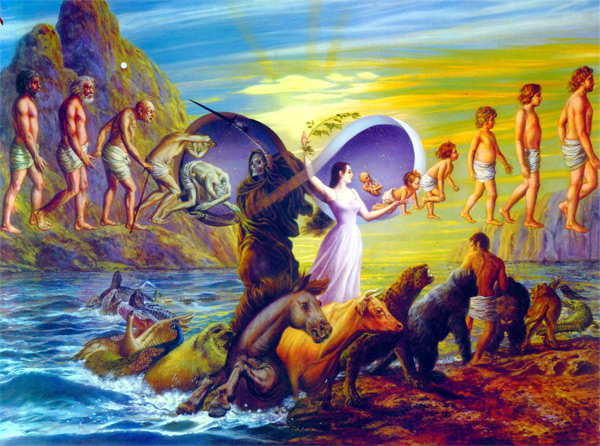
When the living entity wants to enjoy the modes of material nature in their totality, he prefers, out of many bodily forms, to accept that body which has nine gates, two hands and two legs. Thus he prefers to become a human being or a demigod.
[Srimad Bhagavatam 4:29:4]
Srila Bhaktivedanta Swami says, in his purport to this verse:
This is a very nice explanation of how the spiritual being, the part and parcel of Krishna, God, accepts a material body by virtue of his own desires. Accepting two hands, two legs, and so on, the living entity fully enjoys the modes of material nature. Lord Krishna says in Bhagavad-gita (7:27):
O scion of Bharata [Arjuna], O conqueror of the foe, all living entities are born into delusion, overcome by the dualities of desire and hate.
Originally the living entity is a spiritual being, but when he actually desires to enjoy this material world, he comes down. From this verse we can understand that the living entity first accepts a body that is human in form, but gradually, due to his degraded activities, he falls into lower forms of life – into the animal, plant and aquatic forms. By the gradual process of evolution, the living entity again attains the body of a human being and is given another chance to get out of the process of transmigration. If he again misses his chance in the human form to understand his position, he is again placed in the cycle of birth and death in various types of bodies. … As soon as one desires to enjoy his senses, he puts himself under the control of material energy and automatically, or mechanically, is placed into the cycle of birth and death in various life-forms.
[Srila Bhaktivedanta Swami, from his purport to Srimad Bhagavatam 4:29:4]
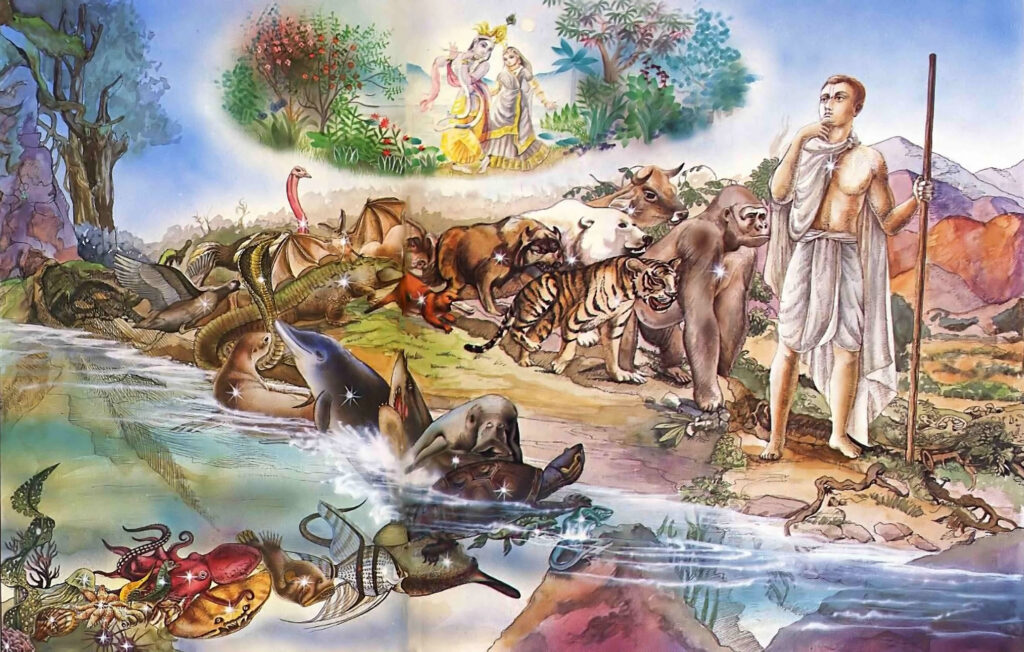
The Vedic understanding of evolution is that it is an evolution of consciousness, rather than Darwin’s theory that the physical forms evolve from one species to another. Basically, as the soul’s consciousness evolves, it is awarded a suitable, more advanced body to facilitate the higher consciousness. Darwin could perceive that there seemed to be a hierarchy or progression in bodily forms and speculated that this was due to one species evolving into another species. He had no knowledge of the soul as the animating principle within the material body. Nor could he understand how the soul within each living creature manifested consciousness according to the degree of its material conditioning or lust:
As fire is covered by smoke, as a mirror is covered by dust, or as the embryo is covered by the womb, similarly, the living entity is covered by different degrees of this lust.
[Bhagavad-gita 3:38]

In the purport to this verse, Srila Bhaktivedanta Swami explains:
… The embryo covered by the womb is an analogy illustrating a helpless position, for the child in the womb is so helpless that he cannot even move. This stage of living condition can be compared to that of the trees. The trees are also living entities, but they have been put in such a condition of life by such a great exhibition of lust that they are almost void of all consciousness. The covered mirror is compared to the birds and beasts, and the smoke covered fire is compared to the human being. In the form of a human being, the living entity may revive a little Krishna consciousness, and, if he makes further development, the fire of spiritual life can be kindled in the human form of life. By careful handling of the smoke in the fire, the fire can be made to blaze. Therefore, the human form of life is a chance for the living entity to escape the entanglement of material existence. In the human form of life, one can conquer the enemy, lust, by cultivation of Krishna consciousness under able guidance.
Under the direction of Lord Krishna, Brahma has empowered various demigods to create, fully manifested, the forms for all of the various species of life. This is described in some detail in different parts of Srimad Bhagavatam, but especially in thr sixth canto. We are not so foolish as to not admit that there is a degree of material evolution which is clearly visible. We can call this micro-evolution, and it is from this undeniable process that the illustrations for many of Darwin’s arguments came. He said that when we get a mutation in a species which adds to its survival value, the mutation is incorporated into that species and so the species evolves or improves.

For instance, Darwin noted that in Northern England, there was a particular species of moth that was predominantly white, with the occasional black variation. Because the skies were clear prior to the industrial revolution, the black moths were an easier target for birds, and so the white moths prevailed. However, during the industrial revolution, the skies in the industrial towns of Northern England turned dark with pollution and smoke. Gradually, as the white moths were a clearer target against the dark sky, the black moths became more prevalent. So, the moths evolved to adapt to their environment. This is an example of micro-evolution. There are many other obvious examples of micro-evolution, such as breeding birds and dogs to change their looks and characteristics, breeding livestock to provide a more saleable product, genetic modification of plants to increase yields or reduce diseases, finches evolving different beaks to adapt to different food environments etc. etc.
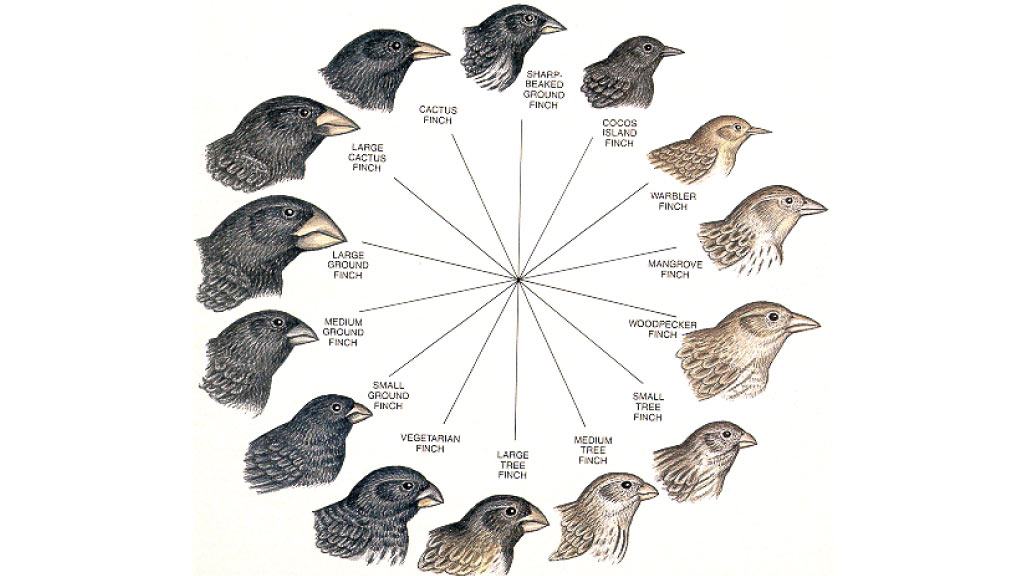
So, while we have no problem acknowledging micro-evolution – minor variations within a species – we do not accept that one species evolves into another species. Micro-evolution is easily observable. There is no observable evidence for one species evolving into another species. Darwin’s Theory remains a theory because in 200 or so years they have found no “missing link” which proves that one species has evolved from another.
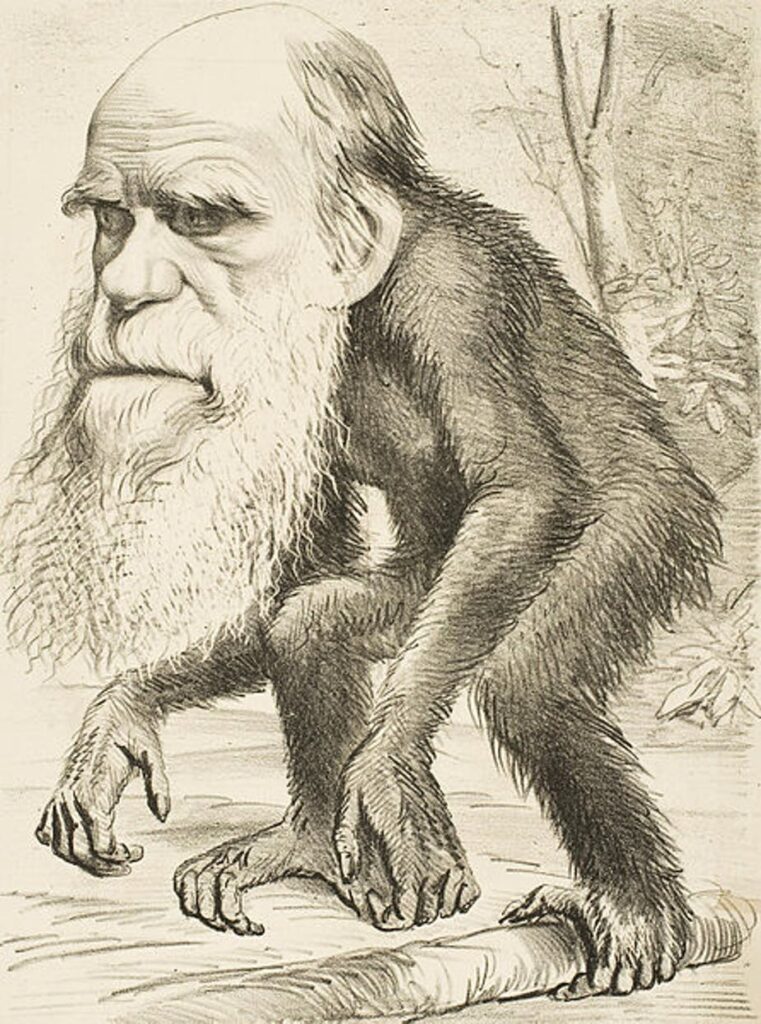
The Vedic version is that each species has been created by Krishna, who is described in Bhagavad-gita as the “seed-giving father” of all species of life:
It should be understood that all species of life, O son of Kunti, are made possible by birth in this material nature, and that I am the seed-giving father.
[Bhagavad-gita 14:4]
Purport by Srila Bhaktivedanta Swami:
In this verse it is clearly explained that the Supreme Personality of Godhead, Krishna, is the original father of all living entities. The living entities are combinations of the material nature and the spiritual nature. Such living entities are seen not only on this planet, but in every planet, even in the highest where Brahma is situated. Everywhere there are living entities; within the earth there are living entities, even within water and within fire. All these appearances are due to the mother, material nature, and Krishna’s seed-giving process. The purport is that the living entities, being impregnated in the material world, come out and form at the time of creation according to their past deeds.

I am the source of all spiritual and material worlds. Everything emanates from Me. The wise who know this perfectly engage in My devotional service and worship Me with all their hearts.
[Bhagavad-gita 10:8]
Know that all beautiful, glorious, and mighty creations spring from but a spark of My splendor.
[Bhagavad-gita 10:41]
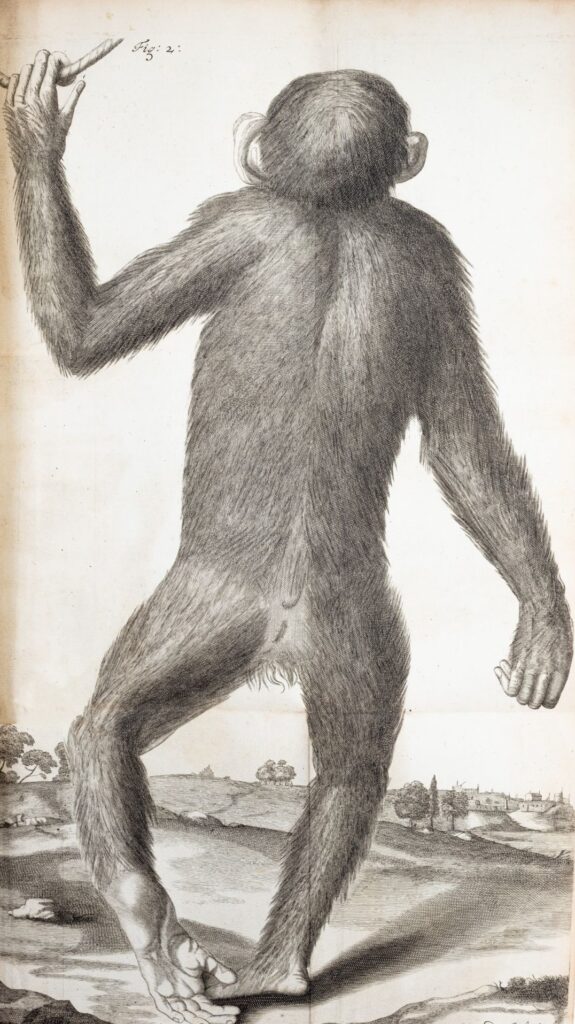


Comment
Great stuff – thanks for all the research